In this blog post, I will be providing an overview of the different types of Jollof Rice dishes across West Africa, looking at ingredients, techniques and preparation.
Disclaimer
If you are vegan (like I am) please be aware that I will be discussing the use of animal products in this post. It is the reality of making Jollof Rice across West Africa. This blog post intends to describe Jollof Rice across the continent. Also, everyone makes their jollof rice differently. The examples provided are broad categorizations and should not be taken as the way EVERYONE in that country makes their jollof rice.
The amount of detail for each section is a direct correlation of what is available on the internet. Some countries have more information than others. So please be gentle on the countries I was not able to find as much information on.
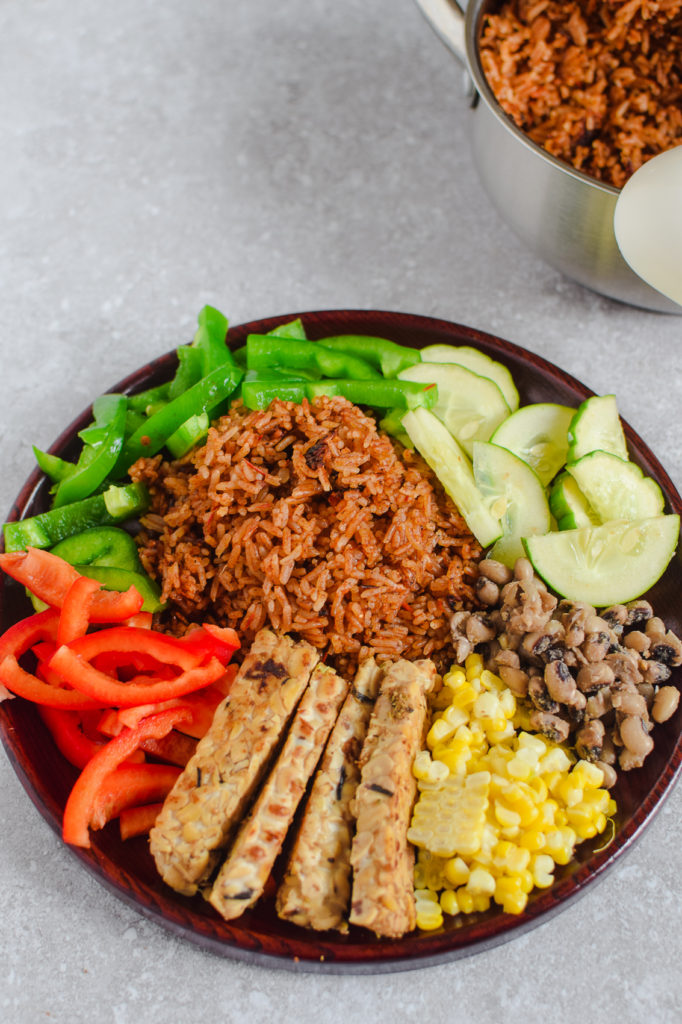
What is Jollof Rice
Jollof Rice is a popular dish across West Africa where rice is cooked in a flavorful tomato-based sauce with protein. If you want to learn more about the history of Jollof Rice, please check out this post: Jollof Rice History. If you want to try it out for yourself, I have an in-depth step-by-step Jollof Rice recipe you can check out: The Tastiest Vegan Jollof Rice.
Can we even compare Jollof Rice?
Jollof Rice across West Africa changes a lot from region to region. For this reason, it can be quite difficult to compare across the continent. Differences in Jollof Rice across this part of the African continent boil down to the choice of rice, how the tomato stew is made, whether vegetables are included and to what extent, whether it is a true one-pot dish (as in everything is cooked together) or includes steps where ingredients are removed and reintroduced. In this blog post, I hope to share what makes each country’s Jollof unique. I think the comparisons have really just become a means of national pride than they have become serious competition, but you can be the judge of that yourself.
Senegambian Jollof Rice
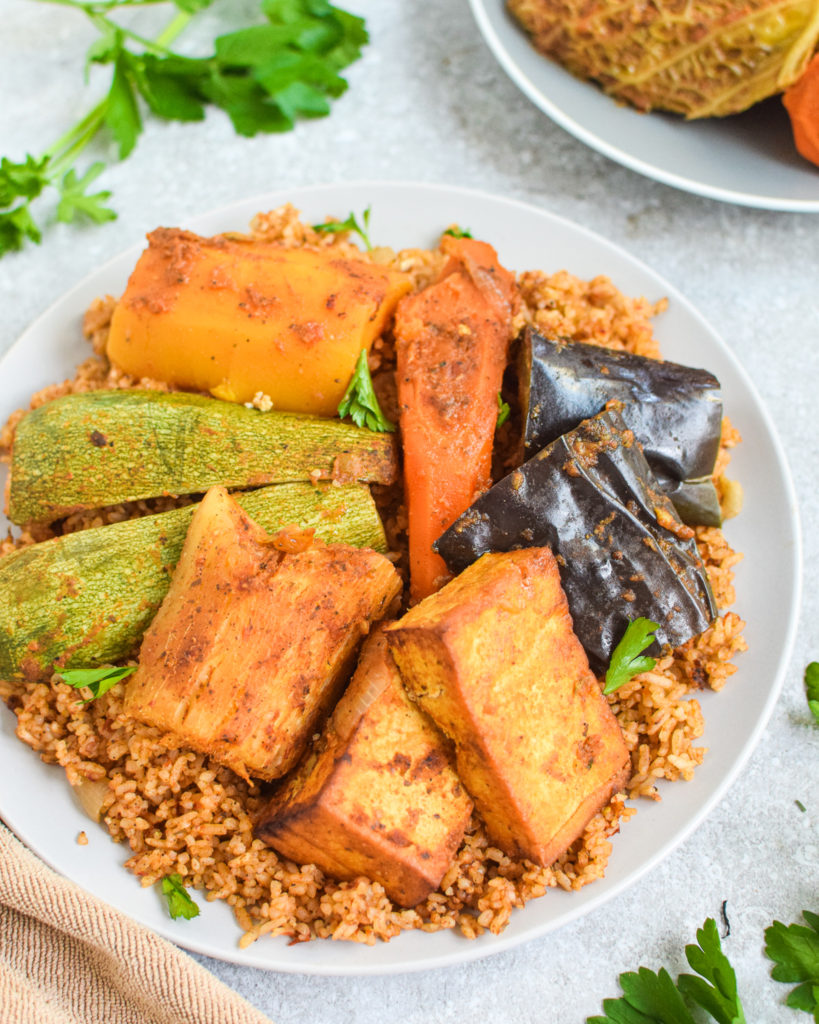
What is it?
The originators of Jollof Rice. Even though the rest of West Africa might use the name Jollof Rice, taken from the Jolof/Wolof tribe in Senegal, Jollof in Senegal and Gambia are known by different names: thieboudienne/cheebu jën and benachin, respectfully. Their Jollof Rice is a product of their environment as it is heavily reliant on fish. It is also a product of colonial influence with the use of herbs, tomatoes, onions, root vegetables and vegetables that are not typically indigenous to Senegambia. Senegambian Jollof Rice is also not for the faint-hearted. There are multiple steps needed to build a ton of flavour and complexity.
How is it made?
First, fish is stuffed with a herb paste with lots of onions, parsley, jalapeño, and green onions. The fish is then fried in oil and then set aside. The jollof rice stew is made with onion, tomatoes, tomato paste, ginger, garlic, leftover herb paste and fermented fish (in Ghana we call this momoni but Senegalese call it yèt).
I have seen some recipes that use just tomato paste instead of fresh tomatoes as the paste is incredibly red. Once the stew has come together the fish is reintroduced with a lot of whole vegetables and root vegetables: carrot, eggplant, cassava, (which some fry before frying the fish), sweet potato and cabbage till they are tender. All the vegetables and fish are removed sequentially based on what is cooked first. The broken rice is then introduced into the sauce (some microwave it first) and then cooked together. The Jollof is served in one large bowl and topped with the fish and vegetables, like the video below.
Click here to check out a French Version (click here)
Guinean and Malian Jollof
These three countries (Guinea, Guinea Bissau, Mali) make their Jollof similar to that of Senegambia. It is known as Zaame in Mali and I am yet to find more details on Guinean Jollof’s local names. They are fish-based and use whole vegetables but I do not believe they are stuffed with the herb paste.
Sierra Leonean Jollof
Sierra Leonean Jollof is a great transition point between Senegambian Jollof and the jollof you will start to see as you move along the coast towards Nigeria. It includes a lot of the same vegetables (cabbage, carrot and pepper) but these vegetables are chopped up and mixed in. It is also incredibly heavy on the onions. Plus, we lose the use of fish and move on to other choices of protein.
The protein (chicken or beef) is fried in oil. The meat can be removed or kept in. The Jollof started with a lot of onions and cooked with tomatoes, tomato paste, seasoning and some veg like chopped carrots and chopped bell pepper. I have been told that cabbage can either be added in the stew process or added when the rice is mixed in. The stew is divided as Sierra Leonean Jollof is served with the stew used to make the Jollof. The rice of choice varies. I have been told jasmine rice and parboiled rice are used, just depends on the cook. The proteins can be kept in with the stew or cooked with the rice. To cook the rice, the liquid used to steam the protein is used to cook the rice. For a visual representation, please check out this video below, as well as the recipe links below.
I had a lot of feedback from Sierra Leoneans on my blog to tell me what makes their Jollof unique. I have included a link to a blog post by Elsie at thecookingwardrobe that you can check out for the process. Click here for the recipe. Massive thank you to Sheena Cooper (@coopsheena on Instagram for all their information)
Liberian Jollof
Liberian Jollof rice might look similar to jambalaya for many people who are unfamiliar with Liberian Jollof Rice. It includes an assortment of meats like sausage, chicken as well as shrimp. The proteins are fried in oil and then set aside. The remaining oil is used to make the stew, including onions, bell pepper, garlic, tomatoes, tomato paste, and cut frozen veg. The rice is included (can be jasmine) and the proteins are reintroduced into the pot and cooked together till the rice is well cooked. It really is a one-pot dish as everything is cooked together. Seasoning is kept to all purposes seasoning like Maggi cube, adobo with some addition of curry powder or thyme depending on the cook.
A video you can check out to look at the process.
Another video you can check out (click here)
Riz au Gras (Francophone Jollof Rice)
Aside from Senegal and Mali, Jollof rice in Ivory Coast, Burkina Faso, Benin and Togo are named Riz au Gras/Riz Gras. Aside from the difference in name, they are quite similar to the Jollof Rice recipes from Nigeria and Ghana. Across the board, they are truly one-pot dishes. I have come across a variety of youtube videos from people in these countries and the process looks similar. The protein is fried in oil and the stew is made with the fried protein and oil. The rice is also added to this pot and everything is cooked together. Some add veg others do not add veg. For a visual look, please check out these videos. I have seen some recipes made with short-grain rice, I have also seen some made with parboiled and others made with jasmine rice.
Something worth noting, I found a recipe for Benin Jollof rice that used baking soda to cut through the acidity of the tomatoes in the stew. If you are Beninois and you happen to know more about this, please leave a comment down below.
Ghanaian Jollof
What is it
When you look up Jollof Rice on the internet, you will most likely find Jollof Rice recipes from Ghana or Nigeria. Ghanaian jollof is similar yet different to other Jollof Rice options. It probably has the most variation of spices and choices of protein (albeit only one protein is used per dish — chicken, beef, turkey, goat or even guinea fowl).
How is it made
The protein is first steamed with onions and spices (garlic, ginger, anise seeds, star anise and magi cube) to infuse a ton of flavour. When the protein is cooked, it is fried in oil and then set aside to make the stew. The same oil is used to fry onions and tomato paste. Then a purée of onions, garlic, ginger and tomatoes are fried in the mixture.
Ghana Jollof uses a considerable amount of ginger and does not usually use any bell pepper in the stew. I find that only Ghanaians outside of Ghana use red bell pepper to add more colour and sweetness to the Jollof since the tomatoes in the US or UK are not like Ghanaian tomatoes.
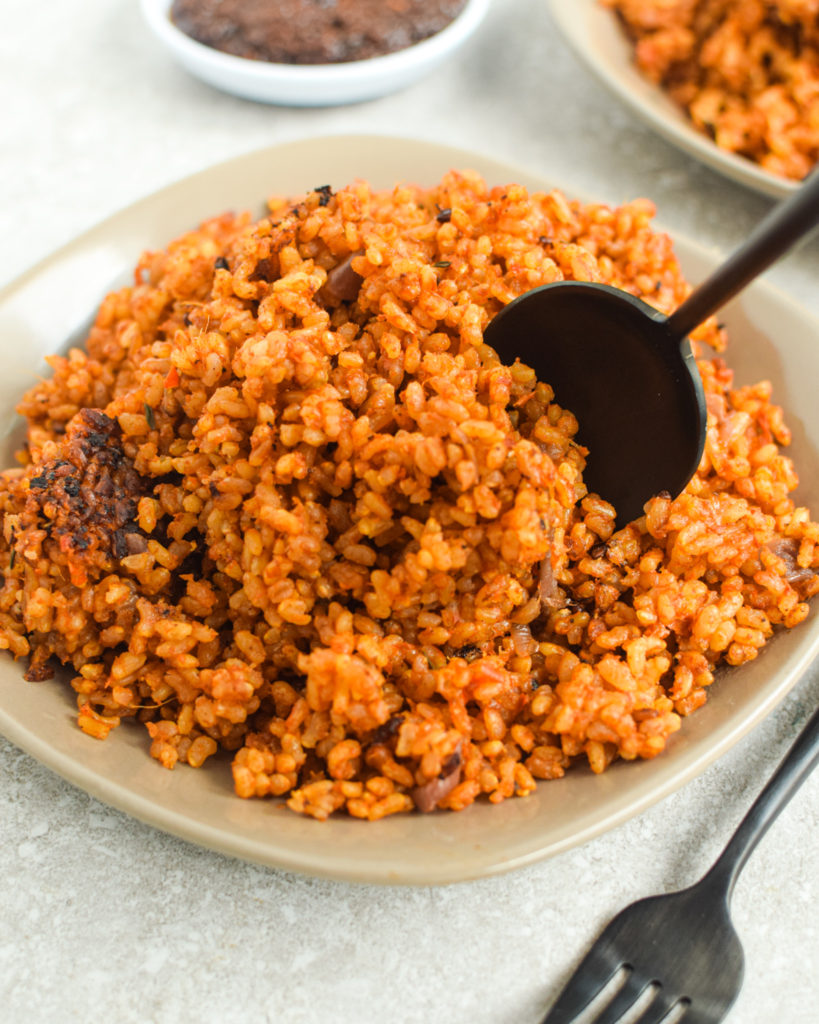
A lot of spices are also included in the stew; like anise seeds, star anise, bay leaf, curry powder, black pepper and then maggi cubes. Anise seeds are very unique to Ghanaian food and add a subtle liquorice flavour; a little goes a very long way. Once the stew has been cooked well, the rice is added.
Typical Ghanaian Jollof uses long-grain, scented jasmine rice. This rice is incredibly starchy and needs to be well washed. The Jollof can be cooked with water but most often it is cooked with the liquid used to steam the protein. The rice is cooked for a long time at very low heat by covering the pot with tin foil or aluminum. The Jollof is served with shito, coleslaw/Ghana Salad and the protein that was fried before. If the Jollof is beef Jollof, the fried beef is added to the pot with the rice and cooked together.
I have a vegan friendly Ghanaian jollof rice that you will love (click here for the recipe). In fact, this is actually how my mother used to make jollof even before I went vegan. This goes to show how much there is variation amongst cooks.
Nigerian Jollof
Ahh, the Nigerians. They claim to make the best jollof rice. But do they really? I will leave you to be the judge of that.
Nigerian Jollof is actually made in an incredibly similar fashion to Ghana Jollof Rice. Basically carbon copy, except for a few steps. So instead of repeating the same process again, I will tell you what makes Nigerian Jollof different from Ghanaian jollof.
How is Nigerian Jollof Made?
Nigerian jollof uses far more bell peppers than any other country. You name it, they use it. The bell peppers are blended with the onions, garlic, ginger and a little bit of tomatoes and then cooked on the side to evaporate as much of the liquid as possible. This concentrated mix is then fried with the fried onions and tomato paste, just like you will Ghanaian jollof Rice. Although Nigerian Jollof uses a variety of spices, it is not to the extent of Ghana Jollof Rice. Typically you will see curry powder, white pepper, thyme, bay leaf and maggi cube. Some also add herbs like rosemary. The next major difference is that Nigerians use long grain parboiled rice. It is well washed and then added to the pot of stew. Nigerian jollof rice is usually served with the fried protein and maybe Nigerian Style salad.

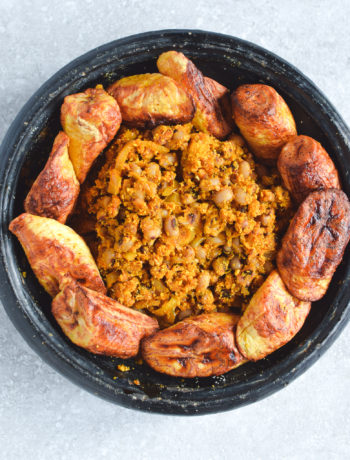

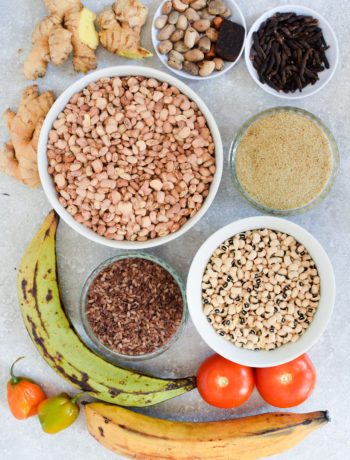
11 Comments
Nat
April 9, 2021 at 3:22 amThis series has so much work put into it, im learning so much
Lauren S
April 9, 2021 at 5:53 amI learned so much! This is a very well thought out and organized post. Can’t wait to to try jollof here in Los Angeles one day.
David O
May 8, 2021 at 2:27 am“They claim to make the best jollof”. Biko, please, we don’t claim, it is an objective fact that we make the best jollof. Period!
Ellarh
May 11, 2021 at 9:09 pmGhana has the best jollof period!!!!
Senegal: vegan thieboudienne - Vegan Physicist
June 28, 2021 at 4:36 am[…] Amoako (The Canadian African) who has a great series about Jollof rice, including a post on how the dish varies across the region and the history of the […]
doo-moviefree24.com
November 17, 2022 at 3:10 amWow, this post is nice, my younger sister is analyzing these things, thus I am going to
inform her.
Also visit my homepage; ดูหนังออนไลน์ avatar; doo-moviefree24.com,
อ่าน manga plus ภาษาไทยยังไง
November 17, 2022 at 4:03 amHowdy! Do you know if they make any plugins to assist with Search Engine Optimization? I’m trying to get my
blog to rank for some targeted keywords but I’m
not seeing very good results. If you know
of any please share. Cheers!
Feel free to visit my website อ่าน manga plus ภาษาไทยยังไง
Less Popular Jollof Rice Recipes you Need To Know About - The Canadian African
December 2, 2022 at 12:45 am[…] Before we get into the post, if you are new here and are wondering what exactly Jollof Rice is, please check out a series of blog posts I have done on Jollof Rice. For details on what it is and a recipe, check out my Jollof Rice Recipe. To learn more about Jollof Rice History, please check out this post. And lastly, to learn about the most popular ways to cook Jollof Rice depending on the country, please check out this post. […]
Simple Vegetarian Jollof Rice - The Canadian African
February 6, 2023 at 3:03 am[…] Who Has the Best Jollof Rice – This post describes the unique jollof rice varieties you can find accross West African countries […]
Nokoss Tofu - The Canadian African
March 20, 2023 at 6:28 pm[…] in Senegal, Roff in Gambia). I first came across the recipe as I was researching Thieboudiene (Senegalese Jollof), which is a fish-based jollof rice. In a typical theiboudienee recipe, the fish is stuffed with […]
Fish Free Thieboudienne - The Canadian African
April 1, 2023 at 9:52 pm[…] This fish free thieboudienne recipe is a labour of love with lots of components that give it a delicious flavour. It differs a lot in technique, ingredients, method and name from the Nigerian or Ghanaian Jollof, which most people know about. You can find more details about this in my blog post dedicated to all types of Jollof Rice in West Africa. […]